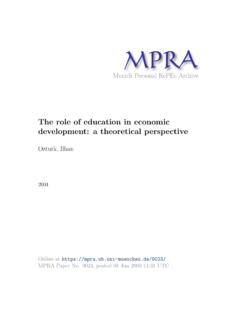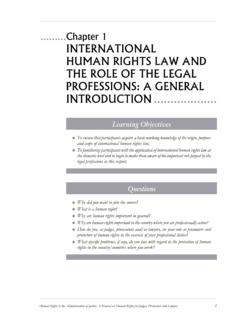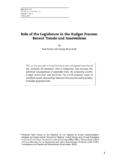Transcription of The Historical Role of Women in Higher Education
1 Administrative Issues Journal: Connecting Education , Practice, and Research (Spring 2015), Vol. 5, No. 1: 3-14, DOI: The Historical Role of Women in Higher Education Patsy Parker, Southwestern Oklahoma State University ABSTRACT. Historically, females, as compared to males, have represented a lower percentage of college professors and administrators in the United States. The tendency for males to outnumber females in the professoriate and college administration has existed since United States Higher Education institutions formed in the early 1800s and still persists today. Fluctuations in Women 's participation rate have been influenced by the economy's history and society's expectations of females. Observation of the employment trends for females offers an interesting look at the evolving role of Women in the United States workforce, in general, and in the university setting, in particular.
2 Keywords: leadership, Higher Education , gender, female leadership T he role of female professors and administrators in United States Higher Education has evolved, with some interesting twists and turns, since the early 1800s. Even when female employees were rare in business settings, Women found their niche in teaching. However, certain events in United States history called for Women to play important roles in business as well as Education . Observation of the employment trends for females offers an interesting look at the evolving role of Women in the United States workforce, in general, and in the university setting, in particular. In Black Women and White Women in the Professions, Sokoloff (1992) defined the professions as the elite occupations, such as law, medicine, architecture, ministry, dentistry, judicial positions, science, and university teaching.
3 These areas qualify as being distinct because the professions are awarded a high degree of honor and status in United States society, and the employees in these areas have traditionally received substantial internal and monetary rewards for the services they provide. The autonomy of the professionals and the esteem that accompanies their positions can be attributed to the high levels of Education they have achieved. The specialized training they have pursued allocates to them a large body of knowledge and allows them to be classified as experts in their chosen fields. Sokoloff's study revealed that, during the two decades from 1960 to 1980, these professional areas constituted the highest-paid occupations and provided the greatest amount of autonomy and control to white males, the group that comprised the majority of the employees in the professions.
4 PARKER / DOI: Page 3. The semiprofessions were occupations that were not as elite as the professions, but did require some level of Education . They included occupations such as elementary teaching, nursing, librarianship, and social work a list that reflects a female-saturated group of positions. During the decades between 1960 and 1980, white males were predominant in the world of the professions; white females were predominant in the world of the semiprofessions. However, during this same time period, Sokoloff noted, tremendous changes occurred for Women in the workforce. In order to discuss the role of Women in Higher Education , particularly in the professoriate and administration, it is necessary to observe the role of Women in the work force and how the percentages of females in various occupations, but particularly in the professions, have fluctuated during the history of the United States.
5 The following discussion focuses on the occupational groups called the professions. BACKGROUND. Between 1870 and 1930, the percentage of Women represented in the occupational groups called the professions increased from 5% of all employed Women in 1870 to 14% in 1930. The next 20 years saw a decline in the percentage of Women in the professions due to the Great Depression. In 1950, only of professionals were female. Until 1960, professionals were predominately white males; Women and minority men were mostly excluded from the elite group of occupations. For example, in 1960, Women represented one-third of the labor force, but made up only of all lawyers, of clergy, of doctors, and of physicists (Oppenheimer, 1970). At United States universities, Women taught in the soft areas of curriculum, such as foreign languages, literature, and home economics (Kaufman, 1984).
6 During the 1960s, the percentage of professional Women increased slowly, but not until 1970 would Women again claim 14% of the positions in the professions, the same percentage they had claimed in 1930 (Bernard, 1971). During the first half of the twentieth century, Women were not prevented from training for or practicing the professions in the same way as men. Barriers for Women included legal restrictions, quotas, administrative regulations, and anti-nepotism rules (Cott, 1987). Quotas restricted Women 's access to Higher Education as universities set limits to the number of females they would admit. For example, under Stanford's quota system, three males were accepted for every female. In 1969, Yale also set quotas for admittance of Women (Minnich, ). Legislation in the 1960s and 1970s that demanded equal treatment of men and Women helped eliminate some of these barriers.
7 Aside from barriers, there are other reasons why Women have continued to have such low representation in some of the top professions, many of them imposed by Women themselves. One reason is that many Women have simply preferred the female-dominated semiprofessions to the male- dominated professions. National census data reported by The American Association of University Women (2003) indicated the highest proportions of Women 's college degrees were obtained in the traditionally female careers of teaching and nursing. Many Women are still drawn to careers in nursing, elementary teaching, and social work. Part of the joy of the American dream is for each person to find the occupation that suits them best, striving to find their place in the career of their choice. Whether that career choice includes a high-paying job that requires several years of postgraduate Education or a less-well-paying job requiring only a six-week training period, it is each person's right to choose the path PARKER / DOI: Page 4.
8 Most appealing to him or her. With so many Women pursuing training in the semiprofessions, one must assume that careers in the semiprofessions have a significant measure of appeal. Another reason for lower representation of Women in the professions is that, although the percentages of Women in male-dominated fields have increased in recent years, many Women , even in today's society, are not as career-oriented as men. Other duties and tasks take precedence over a career, and Women may spend time raising children or supporting a husband who is pursuing Education or his way up the professional career ladder. Women 's responsibilities in childbearing and domestic duties can infringe on or delay the pursuit of a career. Some Women , either because of personal preference or the responsibilities of motherhood, will choose a lower-paying job that requires less Education .
9 On the other hand, many Women with mothers and grandmothers who were domestic housewives and mothers have chosen not to follow in the footsteps of their previous generations and found joy in the fulfillment of a successful career. Each person and each generation chooses various paths. Although Women have represented a low percentage of the workforce holding a professional position, the percentage of females in the professions is increasing. The United States Bureau of Labor Statistics (2014) indicates females now hold 47% of professional and business service positions. In addition to discussing the reasons for Women 's low percentage of representation in the professions, it is imperative also to observe the reasons that percentage of representation is increasing. The rise in cost of living is one reason there is an increase in Women entering demanding, satisfying careers, such as college teaching and college administration.
10 Few families can survive on one salary and maintain a comfortable standard of living. The rise in the cost of many items greatly exceeds inflation. Today's families demand an improved lifestyle, but that lifestyle comes with a cost. Table 1 features information gathered from the United States Census Bureau (2014) and the Center for Disease Control (2014) and indicates how the standard of living changed between 1970 and 2013. Table 1. Changes in Lifestyle in the United States Item 1970 1990 2005 2012-2013. Average size of new home in square feet 1500 2080 2412 2598. Homes with two or more cars 29% 54% 56% 61%. Median household net worth $24,217 $48,887 $58,902 $68,828. Average work week hours hours hours 47 hours Life expectancy years years years years Note. Recent data was available and reported over a two year period.
















